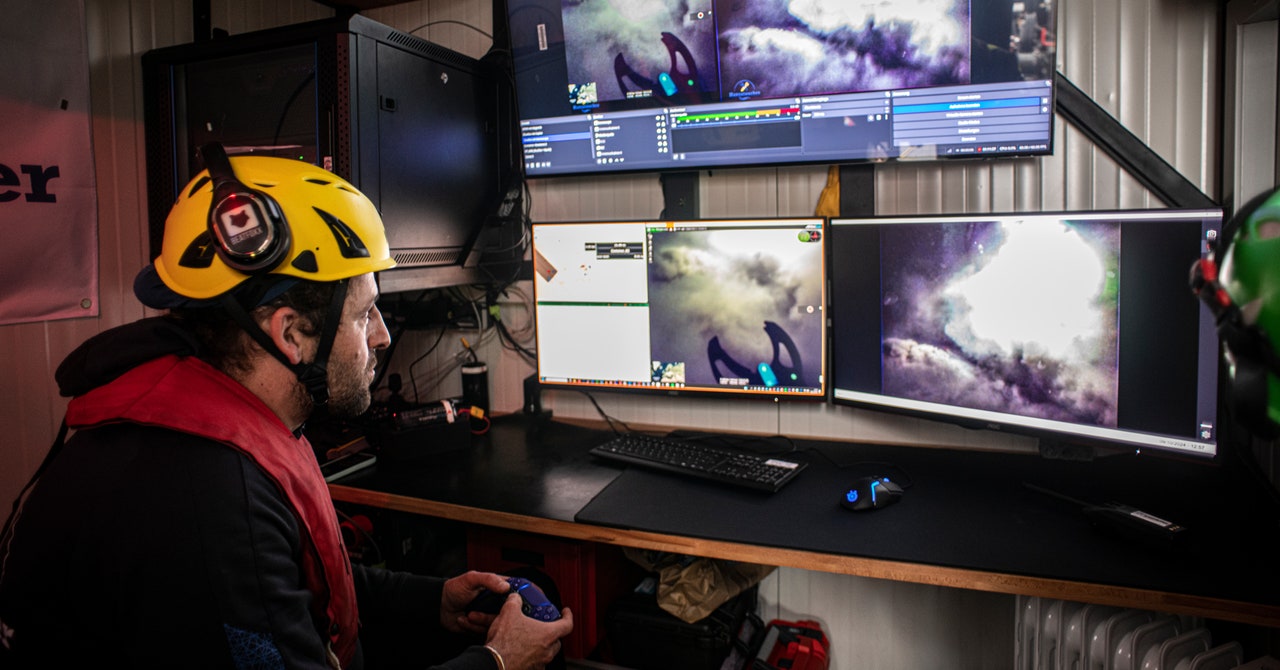When I spoke with Guldin in December, after the first stage of the pilot had finished, he sketched a rough vision of what this work could look like in the not-too-distant future. Robotic crawlers equipped with cameras, powerful lights, sonar, and upgraded grabber systems might be used to pick up munitions more efficiently than the platform-based cranes used now, and could operate around the clock. With remote vehicles, dump sites could also be tackled from multiple sides at once, something impossible to do from a fixed platform on the surface. And ordnance specialists—skilled workers in short supply—could perhaps oversee most of the work remotely from offices in Hamburg, instead of spending days out at sea.
That reality may still be a little way off, but despite a few issues—such as poor underwater visibility and sometimes inadequate lighting, which made operating remotely through live images difficult—most of the technology in the initial tests worked roughly as planned. “There is certainly room for improvement, but fundamentally the concept works, and the idea that you can identify underwater and store it straight away into the transport crates works,” says Wolfgang Sichermann, a naval architect whose company, Seascape, has been overseeing the project on behalf of Germany’s environment ministry. The hope is to start designing and then building the floating disposal facility in the coming months, and begin incinerating the first explosives by sometime in 2026, Sichermann says.
Hands Off?
When I visited the SeaTerra barge on a chilly but clear day last October, I spoke with veteran munitions-disposal expert Michael Scheffler, who’d already spent a month aboard the platform in nearby Haffkrug, on the German coast, carefully cracking open heavy wooden crates caked in mud and slime and packed with 20-mm cannon rounds churned out by Nazi Germany. On that morning, they’d already examined about 5.8 tons of 20-mm rounds, grabbed from the muck by mechanical grabbers and underwater robots and then hauled on board the platform.
Scheffler has spent decades working as a munitions-disposal expert, work he began while serving in the German military. But he’d never fully grasped the extent of the dumped munitions problem—or previously imagined trying to directly tackle the problem in a systematic way.
“I’ve been in the job for 42 years now, and I’ve never had the opportunity to work on a project like this,” he told me. “What is actually being developed and researched here in the pilot project is worth its weight in gold for the future.”
Guldin, while similarly optimistic about the pilot’s results, warns that there are still limits to just how much can be done remotely with technology. The difficult, dangerous, and sensitive work will sometimes still require hands-on human expertise, at least for the foreseeable future. “There are restrictions to doing a complete remote job of clearance on the seafloor. Definitely, divers and EOD [explosive ordnance disposal] specialists on the seafloor and specialists on-site, they will never go away, no way.”
If the initial clean-up effort proves successful, there’s hope the technology might find ready buyers elsewhere—and not only around the Baltic. Well into the 1970s, militaries around the world turned to the oceans as dumping grounds for old munitions.
But since there’s no money to be made in incinerating old aerial bombs, any boom in underwater munitions disposal would depend on major investments in environmental remediation, which happen only rarely. “We could speed up the process and be more efficient, definitely,” Guldin says. “The only thing is, if you bring more resources to the field, it also means somebody has to pay for it. Do we have a government in place in the future who is willing to pay for that? I have my doubts, to be honest.”
“Two weeks ago I spoke to the ambassador of the Bahamas,” says Sichermann. “He said, ‘You are more than welcome to come and clean up everything that the British sank in the ’70s, shortly before the Bahamas became independent.’ But they expect you to bring the money, not just the technology. For that reason, you always have to see who is prepared to finance it.” Find the right financial backers, however, and there will be plenty of potential work around the world, says Sichermann. “There is certainly no shortage of dumped ammunition.”



